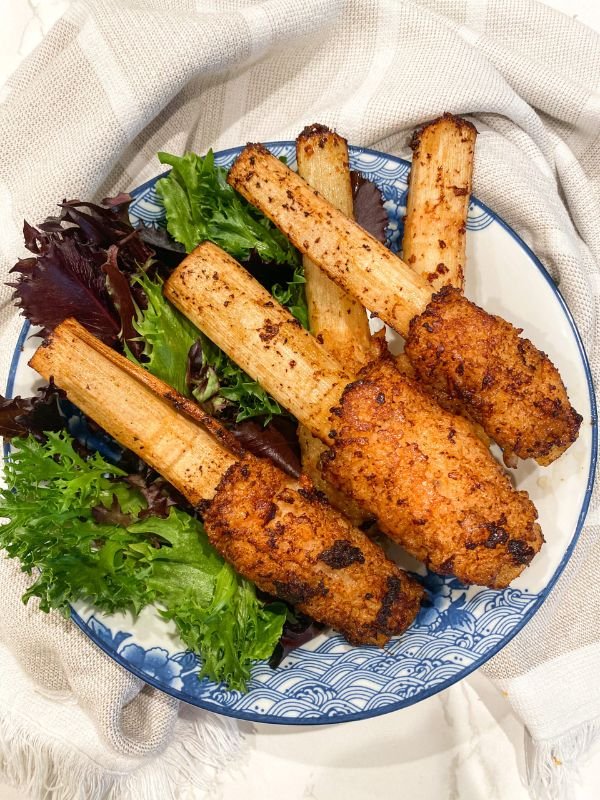I recently tried Vietnamese Chạo Tôm, I couldn’t help but notice the funny part of how these shrimp patties sit perfectly on a sugar cane stick. They are grilled to perfection. They can be served as an appetizer or a snack at banquets, weddings, and casual parties.
I love using Vietnamese sugar cane shrimp because the shrimp patty flavors blend beautifully with the sugarcane stick. Every bite is yummy and tasty. Sometimes, I save leftovers in the fridge. I reheat them in the air fryer, which keeps the texture crisp and the flavor just as good.
The telltale sign of a perfectly cooked patty is its seasoned and slightly smaller pieces. They are easy to eat and share.
Making Chạo tôm at home is a win-win experience. It’s both easy and fun. You can make them for fingers, finger food, or a special dish for family. I often find fresh sugarcane at Asian markets or Trader Joe’s. The backyard grilling adds that extra good taste. Sometimes, I cut the patties into smaller pieces for younger guests.
The excuse of harvest season makes it even more popular. If you opted for a frozen bag, you may find the flavor slightly different. But I recently learned that making them fresh at home brings out the peak yumminess.
This method is great for rules of easy cooking. It’s a treat you’ll often see on the table. It’s much like enjoying Vietnamese Fried Rice Cake With Egg (Bánh bột chiên) or Simple Vietnamese Ginger Braised Chicken (Gà kho gừng) alongside a Vietnamese Braised Pork with Eggs (Thịt Kho) meal.
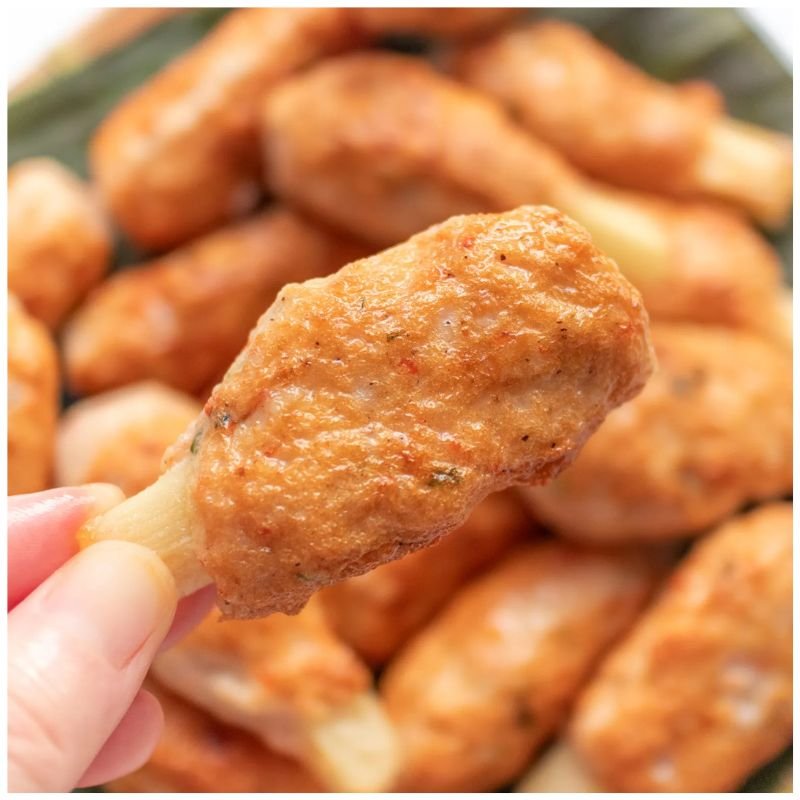
What is Chao Tom?
Chạo tôm is a classic Vietnamese dish. It is made with shrimp paste. The paste is seasoned and wrapped around sugarcane sticks. It is often grilled until golden. It can be served as an appetizer or as a main course. In homes and restaurants, it can be part of a complete meal.
This dish shows the flavors of Vietnamese cuisine and its originating traditions. I enjoy making it at home. The shrimp paste is easy to season. The sugarcane sticks make it fun to handle. The grilled golden texture is always satisfying. It works for a classic appetizer or the main dish of the table.
Where is chạo tôm from?
Chạo tôm is a southern Vietnamese dish. It is often linked to Huế in central Vietnam. There, indigenous cooks and the imperial kitchen of the capital refined its flavors. It is a popular dish at banquet dinners, weddings, and religious holidays. It is commonly served across the country. The origins of chạo tôm are claimed in dynasty accounts, especially during the Nguyen period. It is also made in home cooking, seen in Vietnamese restaurants, and enjoyed outside the country. While less common in some areas, it has been created and adapted by cooks across the country. This shows how a dish from a cultural center can spread and become popular far beyond its initial home.
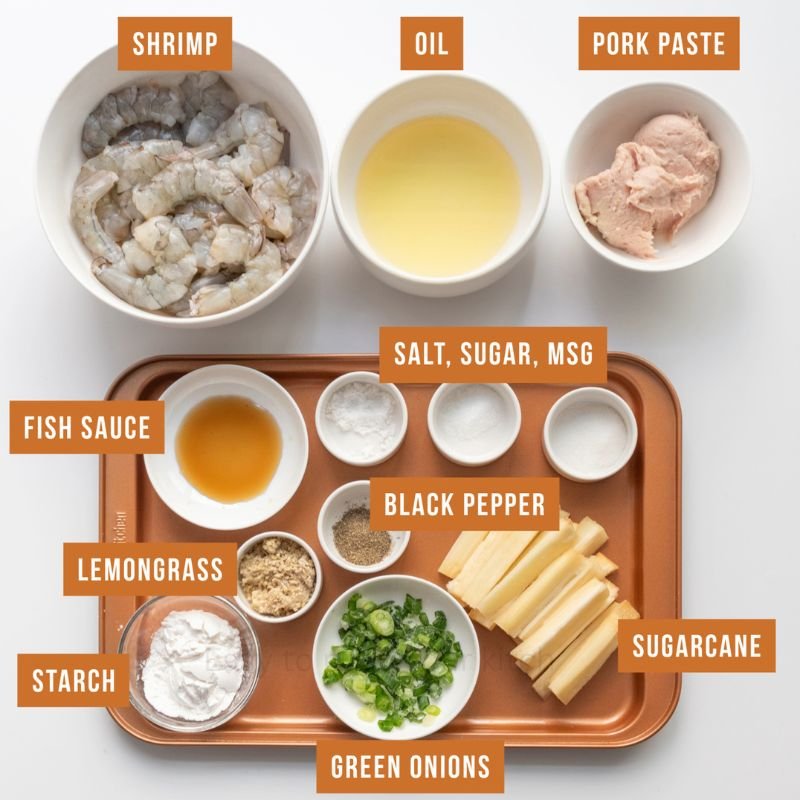
Ingredients for Sugarcane Shrimp
Now, preparing chạo tôm, I like to choose each ingredient carefully to get the best flavor and texture. Below I’ve listed what you’ll need, along with tips from my own cooking experience so you know exactly how to use them.
- Shrimps (deveined and peeled)
- Always use fresh if possible. Frozen works too, but make sure it’s dry before mixing. This keeps the paste from getting watery.
- Always use fresh if possible. Frozen works too, but make sure it’s dry before mixing. This keeps the paste from getting watery.
- Giò sống (Vietnamese pork paste) or ground shrimp
- Adding this gives a velvety texture and helps the paste stick better. I usually mix half shrimp and half pork paste for balance.
- Adding this gives a velvety texture and helps the paste stick better. I usually mix half shrimp and half pork paste for balance.
- Minced lemongrass and green onions
- These add strong aroma and freshness. I learned in my family kitchen that a little extra lemongrass makes the flavor pop.
- These add strong aroma and freshness. I learned in my family kitchen that a little extra lemongrass makes the flavor pop.
- Fish sauce, salt, sugar, MSG, chicken bouillon powder
- This combo builds the core seasoning. Each adds its own layer—sweet, salty, umami. Adjust to taste but don’t skip fish sauce.
- This combo builds the core seasoning. Each adds its own layer—sweet, salty, umami. Adjust to taste but don’t skip fish sauce.
- Ground white pepper and ground black pepper
- Use both for depth. White pepper brings gentle heat, while black pepper adds a sharp kick.
- Use both for depth. White pepper brings gentle heat, while black pepper adds a sharp kick.
- Tapioca starch or corn starch
- These act as binders to make the paste smooth and sticky. I prefer tapioca for a chewier bite.
- These act as binders to make the paste smooth and sticky. I prefer tapioca for a chewier bite.
- Fresh sugarcane (cut into quarter sticks) or canned sugarcane
- Sugarcane works as a semi-edible skewer that gives sweetness while cooking. Fresh has more juice, but canned is a good substitute.
- Sugarcane works as a semi-edible skewer that gives sweetness while cooking. Fresh has more juice, but canned is a good substitute.
- Skewers (if no sugarcane)
- You can find thinner skewers in Vietnamese grocery stores or use bamboo. But sugarcane brings the best flavor and texture.
- You can find thinner skewers in Vietnamese grocery stores or use bamboo. But sugarcane brings the best flavor and texture.
- Neutral oil, canola, or avocado oil
- Use for oiling your hands, wrapping the paste, and frying. Keeps it from sticking.
- Use for oiling your hands, wrapping the paste, and frying. Keeps it from sticking.
- Disposable gloves
- A simple trick: coat your gloves lightly with vegetable oil before shaping. This keeps the paste smooth and the process clean.
- A simple trick: coat your gloves lightly with vegetable oil before shaping. This keeps the paste smooth and the process clean.
- Peanut (optional)
- I sometimes add crushed peanut for a nutty layer. It reminds me of small bánh mì shops where peanuts are used as a garnish.
- I sometimes add crushed peanut for a nutty layer. It reminds me of small bánh mì shops where peanuts are used as a garnish.
- Freezer section option
- If you don’t want to make it from scratch, many markets sell ready-to-cook Vietnamese sugarcane shrimp. Still tasty, though homemade gives better flavor.
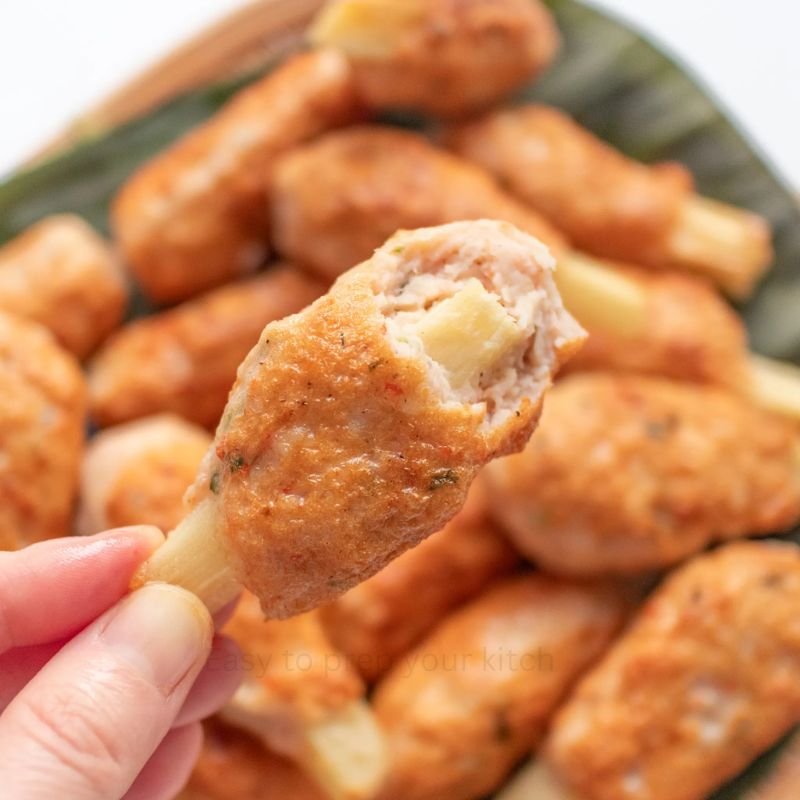
How to Make Chao Tom
Step 1: Prepare the shrimp mixture
I always start with fresh shrimp and pat dry them with paper towels. This step keeps the mixture from getting wet. In a mixing bowl, I add pork paste, sugar, minced lemongrass, and green onions.
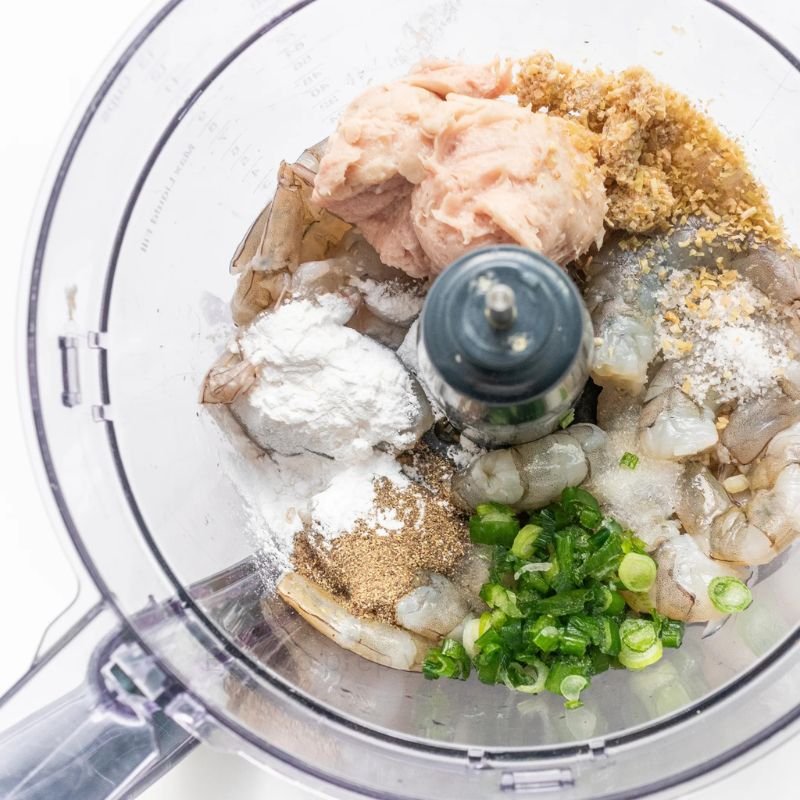
You can pound this with a mortar and pestle until smooth, but to save time, I use a food processor. I add fish sauce and a bit of tapioca starch. These give the paste that bouncy texture that is the signature of this dish.
Sometimes, I press the paste into a Ziploc bag, then flatten and chill it. That makes it easy to mold, portion, and shape later.
Step 2: Make the skewers
Take equal portions of the shrimp mixture and wrap each one around a sugarcane skewer. Press with your hands or a mallet so it holds. If you do not have sugarcane, corn on the cob sticks also work.
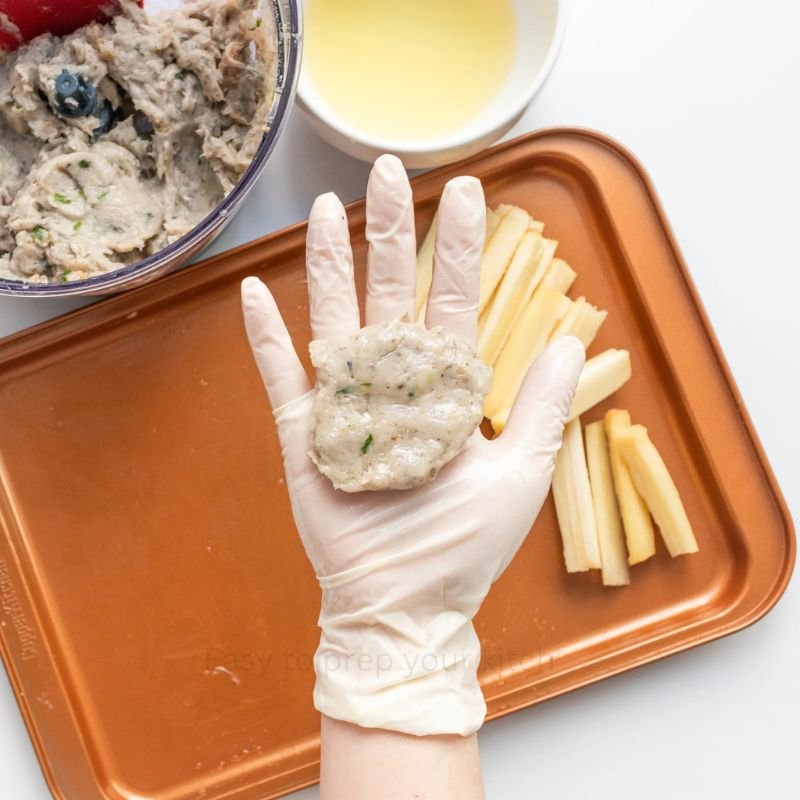
Rub a bit of oil on the end to stop sticking. I wear gloves to keep it neat. Lay the assembled skewers on an oiled sheet pan. Keep the remaining mix covered so it does not dry.
This method makes about 16 skewers.
You can shape them like a lollipop, or flatten and mold as you like.
Step 3: Cook the skewers
You can cook them in several ways. The traditional way is to keep them steamed first. That helps the skewers hold shape and keeps them from deflating or going wrinkly as the paste cools.
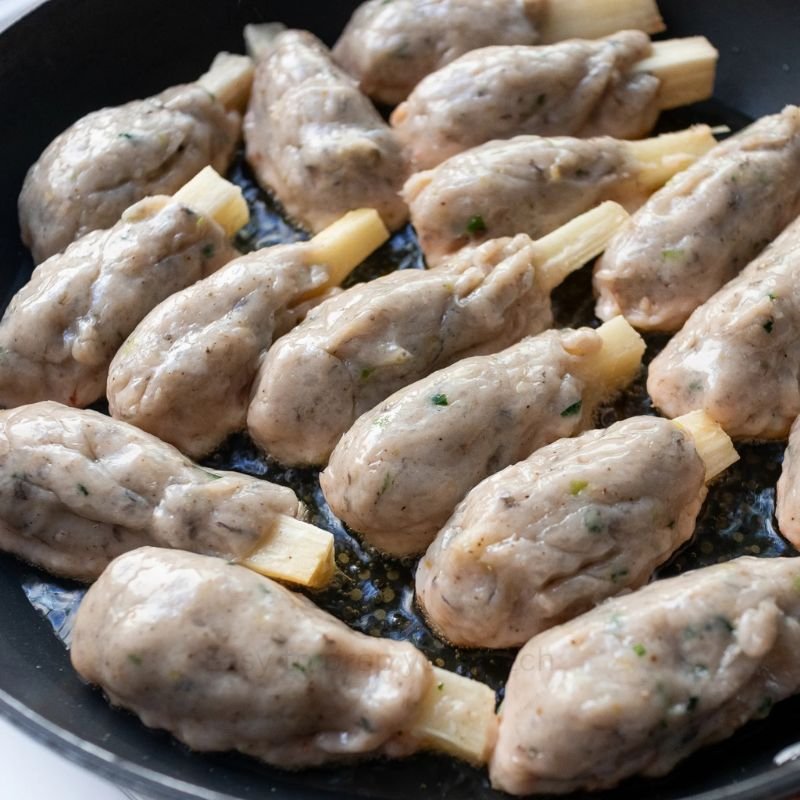
I often skip steaming and cook right away. For the grill method, preheat your grill to medium heat. Lightly oil the grates. Cook for 5 minutes, turning until golden and cooked through.
For the pan-fry method, heat oil in a pan over medium-high. Fry while turning for 5 minutes total until crispy.
For the air fryer method, lightly brush the skewers with oil, then air fry at 380°F for 8 minutes, flipping halfway.
Each style gives a nice texture—crispy outside and juicy inside. I like that it saves me from a dirty pan too.
Expert Tips for making sugar cane shrimp
- Prepare the mixture properly: I start with a food processor to pulse the shrimp paste until it is whipped-like and smooth. Add each ingredient slowly and mix well so the mixture is even. This keeps the texture consistent and ensures each bite cooks the same.
- Form the shrimp: Carefully wrap the mixture around each sugar cane stick using oil hands to stop sticking. Forming the pieces into whole sticks keeps them uniform and easy to handle. I have found that taking a little time here makes cooking much easier later.
- Cooking methods: You can steam or grill for a healthier option or follow traditional ways with fry or an overhead grill. This adds extra flavor and color. Make sure the mixture firm holds shape during grilling or cooking to prevent falling apart.
- Handle with care: Fix any breaks with your hand. Cook in short stages of a few minutes. This keeps the texture right and stops overcooking. Personally, I watch the first batch closely. It helps me cook the rest perfectly.
- Consistency: Follow each step carefully, from sticks to mixture, so the sugarcane shrimp turns out easy to eat, fun, and delicious every time. From my experience, these tips make the dish
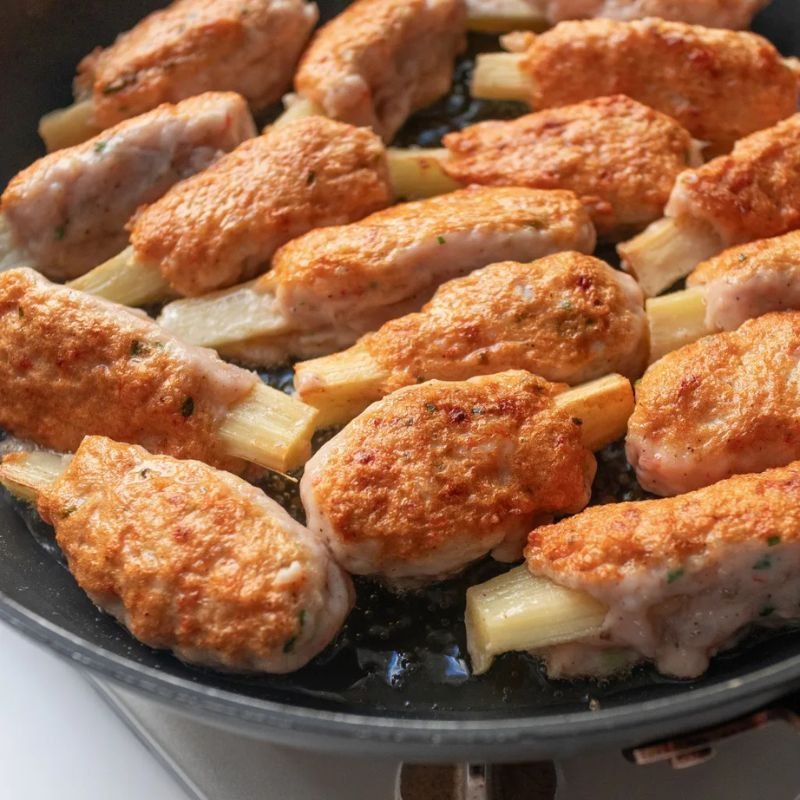
How to Eat Chao Tom?
To eat Chạo Tôm, take the soft shrimp paste and slide it off the sugarcane skewer. Bite gently and enjoy the rich shrimp flavor with the sweet cane juice. Always toss away the woody parts of the sugarcane as you eat.
Some people chew it first and then spit out the hard bits while savoring the sweet juice left behind. Others prefer a neat way. You can nibble slowly and let the sugarcane release its juices with each bite. Each mouthful of Chạo Tôm gives a mix of tender shrimp paste and natural cane sweetness. This balance makes it a tasty and fun dish to enjoy.
How to Serve Chạo Tôm?
When I serve Chạo Tôm, I like to keep it simple but also fun for everyone at the table. The sweet sugarcane holds the soft shrimp paste beautifully, and it pairs well with many Vietnamese dishes. Here are some ways I serve it, based on both tradition and my own kitchen experience:
- 🍚 With cơm tấm (Vietnamese broken rice): Place Chạo Tôm on top of the rice, add a slice of chả trứng hấp (steamed egg meatloaf), and fresh herbs for balance.
- 🍜 With bún thịt nướng and rice vermicelli: Combine with noodles, herbs, and dipping sauce for a complete meal.
- 🥬 As a DIY platter at home: Let everyone grab lettuce, wrap the shrimp with bánh hỏi, and dip it into nước chấm (Vietnamese Fish Sauce Dipping Sauce). This is always a hit with family dinners.
- 🌶️ For extra flavor: Swap or combine sauces with Thai sweet chili dipping sauce.
I also enjoy making Chạo Tôm Cuốn (shrimp and sugarcane spring rolls):
- 🫔 Roll the shrimp in soft rice paper with lettuce and fresh herbs.
- 🥢 Serve with nước chấm for dipping.
- 🍳 Add a slice of chả trứng hấp if you want more comfort in each bite.
If you like experimenting with flavors, try these pairings too:
- 🍚 With cơm chiên Dương Châu (Yangzhou Fried Rice): A perfect East-meets-West combo.
- 🍲 With Lasagna Soup (Vietnamese twist): A fusion that surprises most guests.
- 🥒 With canh bầu tôm (Vietnamese opo squash soup): A light, refreshing option for hot days.
- 🍨 End the meal with sữa chua (Vietnamese yogurt): It adds a sweet, cooling finish.
Whenever I serve it this way, the table feels rich, homestyle, and full of flavor—just like in a traditional Vietnamese family meal.
Vietnamese Chạo Tôm (Sugarcane Shrimp)
Description
Vietnamese Chạo Tôm (Sugarcane Shrimp) is a classic Vietnamese dish. Seasoned shrimp paste is wrapped around sugarcane sticks. You can grill, steam, or pan-fry them until golden. Each bite is juicy, a little sweet, and full of flavor.
It works well as an appetizer or part of a Vietnamese meal. This dish is fun, tasty, and perfect for banquets, weddings, or home cooking. It uses traditional techniques and a playful presentation that everyone will enjoy.
Ingredients
Nutrition Facts
Servings 4
- Amount Per Serving
- Calories 180kcal
- % Daily Value *
- Total Fat 3.5g6%
- Saturated Fat 0.6g3%
- Cholesterol 165mg56%
- Sodium 450mg19%
- Potassium 280mg8%
- Total Carbohydrate 12g4%
- Dietary Fiber 0.8g4%
- Sugars 3g
- Protein 27g54%
- Vitamin A 70 IU
- Vitamin C 6 mg
- Calcium 60 mg
- Iron 1.2 mg
- Vitamin K 2 mcg
- Niacin 3.5 mg
- Folate 12 mcg
- Biotin 2 mcg
- Molybdenum 2 mcg
- Chloride 400 mg
* Percent Daily Values are based on a 2,000 calorie diet. Your daily value may be higher or lower depending on your calorie needs.
Note
- Easy to prepare: Seasoned shrimp paste is simply wrapped around sugarcane sticks, making it a fun and hands-on dish.
- Versatile cooking methods: Can be grilled, steamed, or pan-fried for a golden and flavorful finish.
- Perfect for gatherings: Serves as a delicious appetizer or part of a Vietnamese meal for banquets, weddings, or casual home cooking.
- Juicy and flavorful: Each bite combines the natural sweetness of sugarcane with savory shrimp paste for a tasty experience.
- Traditional yet playful: Uses classic Vietnamese techniques while offering a unique and fun presentation that appeals to all ages.
